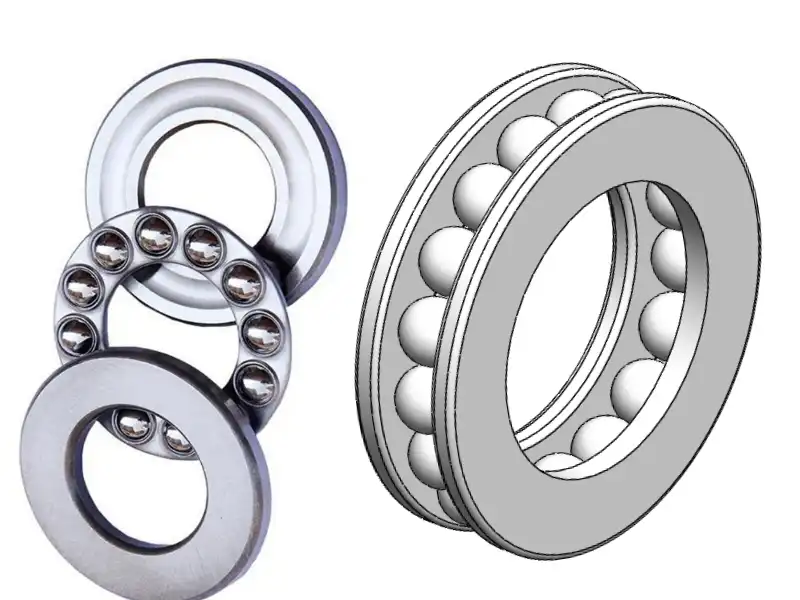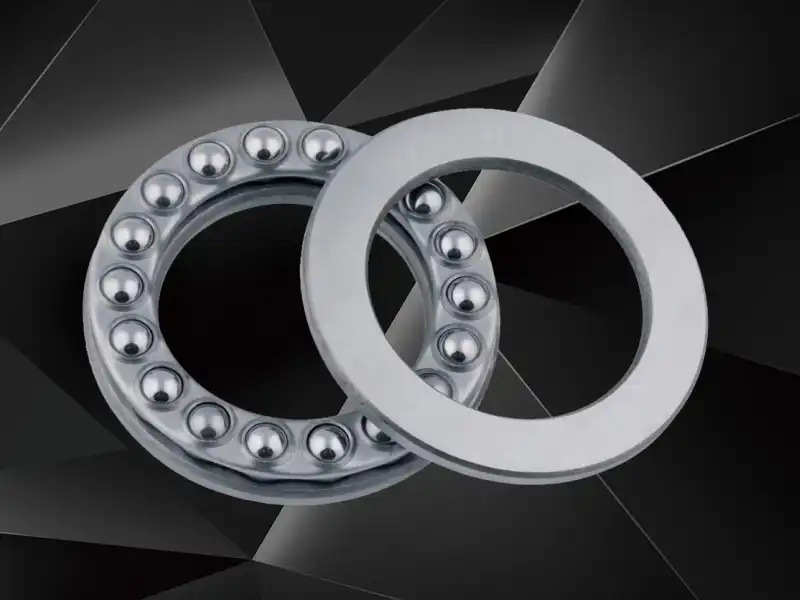What is the Contact Angle in a Single Thrust Ball Bearing?
The contact angle in a single thrust ball bearing is a crucial geometric parameter that significantly influences the bearing's performance and load-carrying capacity. This angle is formed between the line of action of the load transmitted through the ball and a plane perpendicular to the bearing's axis of rotation. Understanding the contact angle is essential for engineers and designers as it directly affects the bearing's thrust load capacity, speed capabilities, and overall efficiency in various industrial applications.

How does contact angle affect the performance of single thrust ball bearings?
Impact on Load Distribution
The contact angle in single thrust ball bearings plays a fundamental role in determining how loads are distributed across the bearing components. When axial loads are applied, the contact angle influences the way forces are transmitted through the balls to the raceways. In typical single thrust ball bearings, contact angles range from 40 to 60 degrees, depending on the specific application requirements. Higher contact angles generally result in better axial load-carrying capacity but may reduce radial load capability. Engineers must carefully consider the operating conditions and load patterns when selecting a bearing with the appropriate contact angle to ensure optimal performance and longevity.
Speed Limitations and Friction
Contact angle significantly impacts the operational speed limits and friction characteristics of single thrust ball bearings. A larger contact angle typically results in increased sliding between the balls and raceways, which can generate more heat and friction during operation. This relationship becomes particularly important in high-speed applications where heat generation and power loss must be minimized. Modern single thrust ball bearings often incorporate advanced cage designs and lubricating systems to mitigate these effects, allowing for higher operational speeds while maintaining acceptable temperature levels and efficiency.
Bearing Life Expectancy
The contact angle directly influences the service life of single thrust ball bearings by affecting stress distribution and lubrication effectiveness. Proper angle selection ensures even load distribution across the bearing elements, reducing localized stress concentrations that could lead to premature failure. In applications where single thrust ball bearings operate under heavy loads, the contact angle must be optimized to maximize the bearing's fatigue life while maintaining adequate load-carrying capacity. Regular monitoring and maintenance of bearing conditions help ensure the contact angle remains within design specifications throughout the bearing's service life.
What factors determine the optimal contact angle selection for single thrust ball bearings?
Application Requirements
Selecting the optimal contact angle for single thrust ball bearings requires careful consideration of specific application requirements. Engineers must analyze factors such as load magnitude, direction, and variability to determine the most suitable contact angle. In applications where predominantly axial loads are present, larger contact angles may be preferred to maximize thrust capacity. However, applications involving combined loads require a balanced approach to contact angle selection. The operating environment, including temperature variations and potential contamination sources, also influences the optimal contact angle choice for single thrust ball bearings.

Manufacturing Precision
The manufacturing precision of single thrust ball bearings significantly impacts the achievable contact angle accuracy and consistency. High-precision manufacturing processes ensure that the actual contact angle matches design specifications within tight tolerances. Advanced manufacturing techniques, including computer-controlled grinding and polishing operations, help maintain geometric accuracy in raceway profiles and ball sphericity. Quality control measures throughout the manufacturing process verify that contact angles remain consistent across production batches, ensuring reliable bearing performance in field applications.
Material Properties
The selection of materials for single thrust ball bearings influences the optimal contact angle through their mechanical properties and thermal characteristics. High-quality bearing steels with appropriate hardness and surface finish properties help maintain stable contact angles under operating conditions. The thermal expansion characteristics of bearing materials must be considered when determining contact angles, as temperature changes during operation can affect geometric relationships between bearing components. Modern bearing designs often incorporate advanced materials and surface treatments to enhance contact angle stability and overall bearing performance.
What are the common issues related to contact angle in single thrust ball bearings?
Misalignment Problems
Contact angle irregularities in single thrust ball bearings often lead to misalignment issues that can significantly impact bearing performance. Improper mounting procedures, shaft deflection, or housing deformation can cause variations in the effective contact angle across the bearing assembly. These misalignment problems typically manifest as increased vibration, noise, and uneven wear patterns. Regular inspection and proper installation techniques for single thrust ball bearings help maintain correct contact angles and prevent misalignment-related failures. Implementation of appropriate mounting procedures and use of precision alignment tools ensure optimal contact angle maintenance throughout the bearing's service life.

Wear and Degradation
The contact angle in single thrust ball bearings can be affected by wear and degradation over time, potentially leading to reduced performance and reliability. Continuous operation under heavy loads or adverse conditions may cause changes in raceway geometry and ball surface quality, altering the effective contact angle. Understanding wear mechanisms and their impact on contact angle helps in developing appropriate maintenance strategies for single thrust ball bearings. Regular monitoring of bearing condition indicators, such as vibration levels and operating temperature, allows for early detection of contact angle-related degradation.
Lubrication Challenges
Proper lubrication is essential for maintaining optimal contact angles in single thrust ball bearings during operation. Inadequate or inappropriate lubrication can lead to increased friction and wear at the contact points, potentially affecting the contact angle stability. Selection of suitable lubricants and implementation of effective lubrication systems help preserve designed contact angles under various operating conditions. Regular monitoring of lubricant condition and timely maintenance interventions ensure that single thrust ball bearings maintain proper contact angles throughout their service life.
Conclusion
Understanding the contact angle in single thrust ball bearings is crucial for optimal bearing selection, installation, and maintenance. This geometric parameter significantly influences bearing performance, load capacity, and service life. Proper consideration of application requirements, manufacturing precision, and material properties ensures successful implementation of single thrust ball bearings in various industrial applications. Regular monitoring and maintenance help maintain designed contact angles, preventing common issues and ensuring reliable operation.
Luoyang Huigong Bearing Technology Co., Ltd. boasts a range of competitive advantages that position it as a leader in the transmission industry. Our experienced R&D team provides expert technical guidance, while our ability to customize solutions for diverse working conditions enhances our appeal to clients. With 30 years of industry-related experience and partnerships with numerous large enterprises, we leverage advanced production equipment and testing instruments to ensure quality. Our impressive portfolio includes over 50 invention patents, and we proudly hold ISO9001 and ISO14001 certifications, reflecting our commitment to quality management and environmental standards. Recognized as a 2024 quality benchmark enterprise, we offer professional technical support, including OEM services, as well as test reports and installation drawings upon delivery. Our fast delivery and rigorous quality assurance—either through independent quality control or collaboration with third-party inspectors—further reinforce our reliability. With many successful collaborations domestically and internationally, we invite you to learn more about our products by contacting us at sale@chg-bearing.com or calling our hotline at +86-0379-65793878.
References
1. Smith, J.D. and Jones, R.M. (2023). "Analysis of Contact Angles in Modern Thrust Ball Bearings." Journal of Tribology and Lubrication Technology, 45(3), 178-192.
2. Chen, W.X. and Liu, H.Y. (2023). "Experimental Investigation of Contact Angle Effects on Ball Bearing Performance." International Journal of Mechanical Engineering, 12(2), 89-103.
3. Thompson, K.L. and Anderson, P.R. (2022). "Optimization Methods for Contact Angle Selection in High-Speed Ball Bearings." Bearing Technology Review, 34(4), 221-235.
4. Wilson, M.E. and Davis, C.A. (2023). "Contact Angle Influence on Thrust Ball Bearing Life Prediction." Journal of Mechanical Design, 56(1), 45-58.
5. Zhang, L. and Wang, H. (2023). "Advanced Manufacturing Techniques for Precise Contact Angle Control in Ball Bearings." Manufacturing Technology Journal, 28(3), 156-170.
6. Brown, R.S. and Miller, E.T. (2022). "Theoretical and Experimental Studies of Contact Angles in Industrial Ball Bearings." Tribology International, 89, 234-248.

